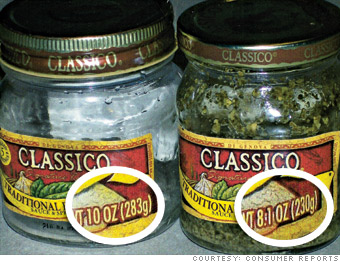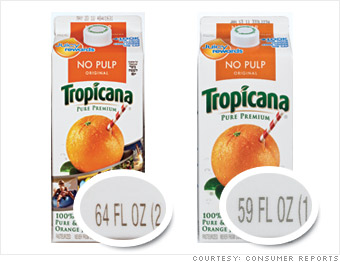January 25, 2011
There is a slow burn going on and it is happening in your wallet and also in the gas tank of your car. The US Treasury and Federal Reserve have made it their mission to slowly cut the value of each one of those green dollars you have. Since many Americans are struggling to make the monthly bills, many producers realize that they cannot up the price on regularly bought consumption products. Places like Target have long learned to add a large section of produce and perishables in their stores since people have shifted from buying wants (HDTVs) to needs (bread and butter). What is interesting though is how the big jump in commodity prices was hidden for consumer goods. You may have noticed this merely by your own observation but creative packaging has hidden a large part of this inflation.
Take for example this article from Consumer Reports:

“Georgia reader Brian Petrino looked at his Angel Soft toilet tissue, labeled “our thickest ever,” and fumed. The old roll had 352 sheets per roll; the new one had just 300 sheets, and they were narrower. “It should say ‘our smallest,’ ” he groused.
From toothpaste to tuna fish, hot dogs to hand soap, companies have been shaving ounces and inches from packaged goods for years, usually blaming it on rising costs for ingredients and energy. They’ve got a point: Higher commodity and fuel costs are expected to cause a spike in food prices by as much as 3 percent in 2011. But if manufacturers are skimping when costs go up, why aren’t they more generous when costs hold steady or fall?
No one likes a price hike, but what riles readers are the ways manufacturers hide their handiwork: indenting the bottom of containers (a favorite trick among peanut butter processors), making plastic wraps thinner, or whipping ice cream so that you pay for air instead of ingredients.”This is absolutely true. Manufactures have developed creative packaging that maintains the same costs but the amount being given has decreased. In the end this amounts to inflation but is a more discrete way of it showing up. This is similar to how the US dollar has been slowly declining for many decades.
So how does this inflation show up?

“(Country Consultant) Tropicana orange juice: 64 oz. container is now 59 oz. – a 7.8 percent reduction.You have to read between the lines in the current crisis. From examining the BLS figures it doesn’t seem like they factor in packaging and look more at individual items (i.e., one bottle of orange juice, one package of Kraft cheese, etc). In the end this hits those on a fixed income hard like many of the millions on Social Security. They are feeling poorer because their purchasing power is slowly slipping away.
Ivory dish detergent: 30 oz. bottle is now 24 oz. – 20 percent reduction
Kraft American cheese: 24 slice package now holds 22 slices – 8.3 percent reduction
Scott toilet tissue: 115.2 sq. ft. now 104.8 sq. ft. – 9 percent reduction
Chicken of the Sea salmon: 3 oz. can now 2.6 oz. – 13.3 percent reduction”
Read the entire article

No comments:
Post a Comment